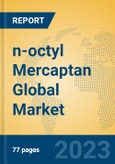Market Size and Growth Forecast
The global n-Octyl Mercaptan market is estimated at USD 42 to 52 million in 2025, with a projected CAGR of 2.5% to 3.5% from 2025 to 2030, reaching USD 48 to 60 million by 2030. This moderate growth reflects consistent application demand, tempered by market maturity and supply concentration.Regional Analysis
- North America: Holding 30-35% of the market share, North America grows at 2-3%. The US leads with strong polymer manufacturing, focusing on antioxidants and chain transfer applications. Trends emphasize sustainable polymer production.
- Europe: Accounting for 25-30%, Europe grows at 2-2.5%. Germany and France drive demand in plastics and antioxidants, with trends toward eco-friendly formulations and regulatory compliance.
- Asia Pacific: Representing 25-30%, this region grows at 3.5-4.5%. China and Japan are key, with China’s industrial scale and Japan’s precision manufacturing boosting use. Trends focus on cost-effective polymer solutions.
- Rest of the World: With 5-10%, this region grows at 2.5-3.5%. Brazil and the Middle East see moderate demand in polymers, with trends targeting industrial growth.
Application Analysis
- Chain Transfer Agent: Expected to grow at 2.5-3.5%, controlling polymer chain length in plastics. Trends focus on efficiency and sustainability.
- Antioxidant: Projected at 2-3%, stabilizing materials against oxidation. Trends emphasize performance in rubber and coatings.
- Others: Anticipated at 2-3%, covering niche chemical uses. Trends explore specialty intermediates.
Key Market Players
- Chevron Phillips Chemical: A leading supplier of mercaptans for polymer and antioxidant uses.
- Arkema: Offers n-Octyl Mercaptan for industrial applications.
- ISU Specialty Chemical: Specializes in sulfur-based chemicals for diverse needs.
Porter's Five Forces Analysis
- Threat of New Entrants: Low; high barriers from monopoly and technical complexity limit entry.
- Threat of Substitutes: Medium; other mercaptans and antioxidants compete, but n-Octyl’s specificity sustains demand.
- Bargaining Power of Buyers: Medium; limited suppliers enhance producer power, though large buyers negotiate.
- Bargaining Power of Suppliers: Medium; petrochemical dependency exists, balanced by sourcing options.
- Competitive Rivalry: High; three players compete intensely on cost and reliability.
Opportunities:
- Rising polymer production in Asia Pacific drives demand.
- Antioxidant needs in industrial materials expand applications.
- Emerging markets offer growth as manufacturing rises.
Challenges:
- Raw material cost fluctuations affect margins.
- Environmental regulations on sulfur compounds increase costs.
- Market dominance by three players limits innovation.
This product will be delivered within 1-3 business days.
Table of Contents
Companies Mentioned
- Chevron Phillips Chemical
- Arkema
- ISU Specialty Chemical








